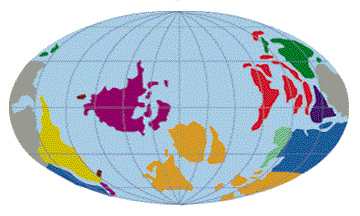This graph shows that the amount of oxygen has increased as the Earth has aged.
Click on image for full size
Kentucky Coal Education Web Site.
The slow build up of Oxygen in the Earth's Atmosphere
It took a long time for oxygen to build up in Earth's atmosphere. At
first the atmosphere was made of hydrogen,
then with volcanic eruptions the atmosphere was made of carbon dioxide, sulphur dioxide, ammonia, and other gases, then the atmosphere was made mostly of nitrogen. Today the atmosphere is 80% nitrogen and 20% oxygen.
In the early Earth there was very little oxygen. At the top of Mt. Everest it is very hard to breathe because there is not enough oxygen. So imagine how hard it would be to breathe in the environment of the early Earth!
The formation of life on Earth played a very large role in the build up of oxygen in the environment. At first, bacteria began to produce oxygen as a waste product of their activity. That oxygen reacted with iron in the ocean to make iron ore. Later, after the iron in the ocean was gone, and the making of iron ore was finished, enough oxygen accumulated for simple organisms, organisms like protozoans, amoeba, etc. which are single-celled, to come to be. The more oxygen accumulated in the atmosphere, the larger became the protective ozone layer (formed from oxygen in the atmosphere). Ozone helped protect developing life from the harmful effects of the Sun's ultraviolet radiation. Then other life forms such as sponges, worms, and other organisms came to be.
Once there was enough oxygen to breathe, and an ozone layer developed, lots of different kinds of life forms, including dinosaurs, came to be. The Earth had entered what is known as the Cambrian age.
You might also be interested in:

Scientists ask many questions. One of the questions they like to ask is "Where did the atmosphere come from?" As always, scientists chip in with many different, and sometimes conflicting answers. Some
...more
The first beings were probably much like coacervates. As a group, these bacteria were heterotrophic , meaning that they ate food which came from somewhere else. Because there was virtually no oxygen in
...more
Eventually, photosynthesis by the earliest forms of plant life (a form of life capable of feeding itself instead of feeding off of others) began to produce significant amounts of oxygen. One important
...more
We all know that today ocean waters are very salty. There aren't many sedimentary rocks older than 2.5 billion years (see geologic time) that means that there must have been mostly igneous rocks at the
...more
The Archean is the name of the age which began with the forming Earth. This period of Earth's history lasted a long time, 2.8 billion years! That is more than half the expected age of the Earth! And no
...more
This period of time in Earth's history is a period when dinosaurs roamed the Earth. This period lasted 37 Million years. During this time, the continents we know today were combined into a giant continent
...more
Once the Earth began to cool, water vapor, one of the volatiles, began to condense and form an ocean. According to the Goldilocks theory, Earth is at just the right distance from the sun for the temperature
...more
Why did the dinosaurs go extinct? No one knows for sure, but there are some explanations that seem to make sense. At the time the dinosaurs and lots of other species died out (which is sometimes called
...more














